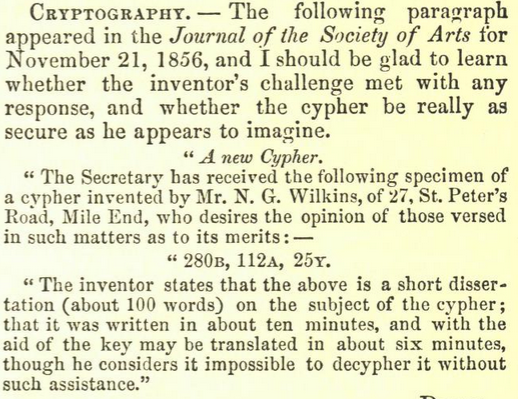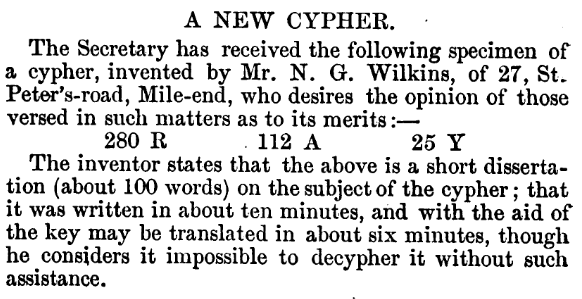Die Zeichenfolge “280 R 112 A 25 Y”, auch beklannt als Wilkins-Kryptogramm, soll einen Text verschlüsseln, der aus etwa 100 Wörtern besteht. Das kann nicht funktionieren – oder vielleicht doch?
English version (translated with DeepL)
Vor sieben Jahren bloggte ich über ein ungelöstes Kryptogramm, das aus nur 11 Zeichen besteht. Inzwischen bezeichne is so etwas als Mikrokryptogramm, doch diesen Begriff habe ich damals noch nicht verwendet.
Das Interessante an diesem Rätsel ist, dass ihm ein scheinbar unmögliches Verschlüsselungsverfahren zu Grunde liegt. Zwar gab es seinerzeit einige interessante Kommentare, doch niemand fand eine Lösung. Nach sieben Jahre möchte ich diesen kryptologischen Cold Case daher heute noch einmal vorstellen.
Das Wilkins-Kryptogramm
Das fragliche Mikrokryptogramm stammt von einem N. G. Wilkins. Daher nannte ich es “Wilkins-Kryptogramm”. Der Leser Hans Jahr hatte mich auf dieses hingewiesen, nachdem er es in folgendem Artikel aus der Zeitschrift Notes and Queries (vom 14. Juni 1862) entdeckt hatte:
Nimmt man den Artikel wörtlich, dann steht da: “Die Buchstabenfolge ‘280B, 112A, 25Y’ ist laut einem Herrn Wilkins die verschlüsselte Version eines 100 Wörter langen Texts. Der Leser soll diese Verschlüsselung knacken.”
Mein erster Eindruck war: Das kann eigentlich nur ein Druckfehler sein. Deshalb schaute ich in der Originalquelle nach, die im Artikel genannt wird (Journal of the Society of Arts vom 21.11.1856). Dort fand ich folgendes:
Hier steht also fast das gleiche. Der einzige Unterschied ist, dass die erste Zeichengruppe ein R statt einem B enthält – wahrscheinlich ein Druckfehler im erstgenannten Artikel. Abgesehen davon hat es Herr Wilkins wohl tatsächlich so gemeint: “280 R 112 A 25 Y” steht für einen verschlüsselten Text, der etwa 100 Wörter enthält. Das Verschlüsselungsverfahren ist nicht angegeben.
Der Klartext ist laut Artikel eine kurze Abhandlung zum Thema Verschlüsselung. Es soll etwa sechs Minuten gedauert haben, diesen Text zu verschlüsseln.
Aus 11 mach 100
Aber wie verschlüsselt man 100 Wörter in nur acht Zahlen und drei Buchstaben? Eigentlich geht das nicht. Die einzige Möglichkeit die ich sehe: Es gibt ein weiteres Dokument, auf das mit diesen Zeichen verwiesen wird. Demnach müsste es sich um so etwas wie einen Wörterbuch-Code oder einen Codebuch-Code handeln.
Am wahrscheinlichsten fände ich einen Codebuch-Code. 1862, als das Kryptogramm entstand, gab es bereits Codebücher mit Zehntausenden von Einträgen, die auch ganze Sätze enthielten. Ein (erfundenes) Beispiel wäre “die Lieferung ist heute angekommen”. Vielleicht verweisen die Zeichenblöcke 280R, 112A und 25Y auf jeweils einen langen Satz in einem Codebuch. Dadurch würde man sicherlich 100 Wörter zusammebekommen.
Ein Wörterbuch oder ein sonstiges Buch ließe sich sicherlich ähnlich nutzen. Natürlich ist es irreführend, wenn man behauptet, auf diese Weise 100 Wörter in 11 Buchstaben verschlüsselt zu haben, doch ganz falsch ist es nicht.
Nathaniel George Wilkins
Vielleicht hilft es weiter, wenn man etwas mehr über N. G. Wilkins, den Erfinder des rätselhaften Verfahrens, weiß. Richard SantaColoma hat herausgefunden, dass dieser mit vollständigem Namen Nathaniel George Wilkins hieß und von Beruf wohl Pfarrer war. Er schrieb ein Buch mit dem Titel “Errors and Terrors of Blind Guides”, in dem er die “Doktrin des immerwährenden Schmerzes” zurückwies. Leider habe ich keine Ahnung, was es mit dieser Doktrin auf sich hat. Vielleicht weiß ja ein Leser mehr.
Richard hat auch Belege dafür gefunden, dass Wilkins sich mit Kryptografie beschäftigte. Insbesondere hat dieser 1904 ein Buch mit dem Titel “The Alaric 3 Cipher” veröffentlicht, das es wohl in der British Library gibt. Ansonsten habe ich nirgends etwas zu diesem Werk gefunden.
Letztendlich ist es natürlich auch möglich, dass Wilkins im Zusammenhang mit seinem Mikrokryptogramm etwas durcheinander gebracht hat. Mehrere Leser haben darauf hingwewiesen. Vielleicht ist “280 R 112 A 25 Y” nicht der Geheimtext, sondern der Schlüssel. Oder Wilkins hat schlichtweg nicht verstanden, wie Verschlüsselung funktioniert.
Kann ein Leser mehr zu diesem kryptologischen Cold Case sagen?
Follow @KlausSchmeh
Further reading: Vier Sprengstoff-Anschläge und eine verschlüsselte Botschaft
Linkedin: https://www.linkedin.com/groups/13501820
Facebook: https://www.facebook.com/groups/763282653806483/





Kommentare (7)